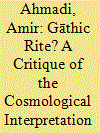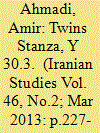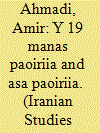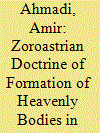| Srl | Item |
| 1 |
ID:
151801


|
|
|
|
|
| Summary/Abstract |
In the last few decades ritual interpretation of the Gāthās has replaced the biblical one as the dominant paradigm. The emphasis on the central role of ritual in the Avesta is well justified. This realization has given rise to the question of the role and meaning of ritual in the Gāthās. Marijan Molé had tried to argue that the Gāthās in fact describe and accompany a rite whose purpose was the preservation/renovation of the cosmic order. Students of the Gāthās working within the new paradigm have taken up Molé’s general frame. They have tried to show that the Gāthās, collectively or individually, is the text of a particular rite that served, among others, to preserve the cosmic order, especially the daily rise of the sun. The article questions the validity of this thesis. Its focus is on the version of the thesis we find in a number of recent publications by Jean Kellens. He tries to show that the first Gāthā (Ahunauuaitī) describes a unitary pre-dawn ritual that comprised a haoma rite and an animal sacrifice, and had cosmological and eschatological pretensions. His textual analyses and arguments are examined in some detail. The article concludes that Kellens's attempt must be deemed unsuccessful.
|
|
|
|
|
|
|
|
|
|
|
|
|
|
|
|
| 2 |
ID:
120859


|
|
|
|
|
| Publication |
2013.
|
| Summary/Abstract |
The Gathic stanza Y 30.3 has always been at the center of various interpretations and controversies in Western scholarship on Zoroastrianism. Those who believe they have discovered in the Gathas a monotheistic religion armored with an ethical dualism have made this stanza one of the pillars of their thesis. The so-called Twins stanza shows, according to this view, that the good and evil primordial spirits exist as a result of their choice between Good and Evil, which preserves not only the absolute goodness of the supreme god but also his uniqueness. More recently Kellens and others following him have given a completely different reading of the stanza. According to their account, this stanza is a speculation on the hidden processes of ritual. What the poet expresses in Y 30.3 is not a dualism, ethical or otherwise, but a psychology of the process by which man makes his choice of ritual conduct. Aside from the question of coherence, one must ask whether these accounts are borne out by the text they claim as their basis. This article addresses these two questions.
|
|
|
|
|
|
|
|
|
|
|
|
|
|
|
|
| 3 |
ID:
124454


|
|
|
|
|
| Publication |
2013.
|
| Summary/Abstract |
Yasna 19 contains an Avestan exegesis of the G?thic stanza Ahuna Vairiia, the most revered text in Zoroastrianism. The stanza is traditionally understood to be the essential statement of the religion of Mazd?. Thus, in Y 19 we have a unique opportunity to ask about the significance that the G?th?s of Zarathuštra held for the later Avestan tradition. In what intellectual horizon did Zoroastrian priests place their founding text? Although Y 19 exegesis of the Ahuna Vairiia contains semantic obscurities, it is possible to establish the meaning of the commentary through syntactic and conceptual analysis of two key terms and the phrases where they occur. The article critically examines the earlier interpretations of the text. Having found these inadequate, it proposes a new reading and understanding of the Avestan exegesis. In particular, the article argues that the Avestan exegete understood the G?thic stanza within an eschatological horizon.
|
|
|
|
|
|
|
|
|
|
|
|
|
|
|
|
| 4 |
ID:
178774


|
|
|
|
|
| Summary/Abstract |
This article is about the doctrine of the formation of celestial bodies in Pahlavi texts. The doctrine is peculiar. It clashes not only with the accounts of the Gāϑā and the Younger Avesta but also with the general cosmology of Pahlavi literature. Nonetheless it must be authoritative since it is found in our main sources of Zoroastrian (Pahlavi) cosmogony and there does not seem to be an alternative account of the formation of celestial bodies. It thus prompts us to look for its background. This article presents and discusses the texts that contain the Pahlavi doctrine, examines its Avestan roots, and shows the influence of Presocratic cosmogonic speculations on the doctrine. Further, comparative material allows us to propose a conceptual genealogy of the basic constituents of the doctrine.
|
|
|
|
|
|
|
|
|
|
|
|
|
|
|
|